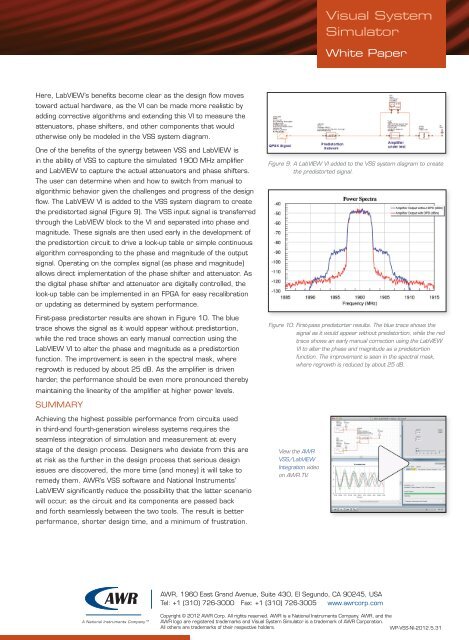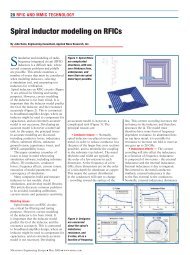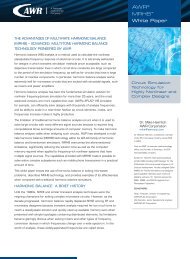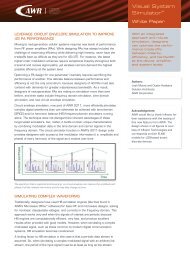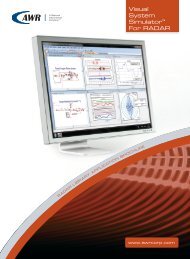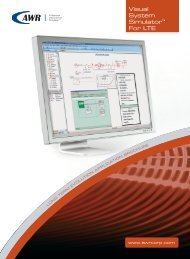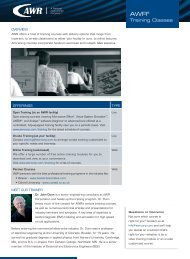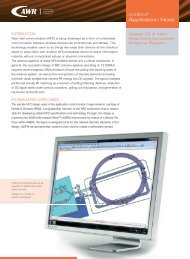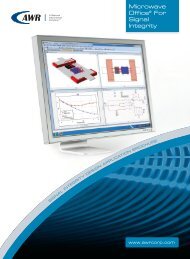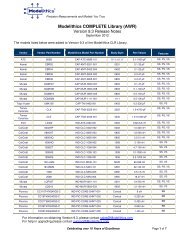Visual System Simulator™
Visual System Simulator™
Visual System Simulator™
Create successful ePaper yourself
Turn your PDF publications into a flip-book with our unique Google optimized e-Paper software.
<strong>Visual</strong> <strong>System</strong><br />
Simulator<br />
(additional positioning<br />
line<br />
AXIEM<br />
here ???)<br />
White Paper<br />
Here, LabVIEW’s benefits become clear as the design flow moves<br />
toward actual hardware, as the VI can be made more realistic by<br />
adding corrective algorithms and extending this VI to measure the<br />
attenuators, phase shifters, and other components that would<br />
otherwise only be modeled in the VSS system diagram.<br />
One of the benefits of the synergy between VSS and LabVIEW is<br />
in the ability of VSS to capture the simulated 1900 MHz amplifier<br />
and LabVIEW to capture the actual attenuators and phase shifters.<br />
The user can determine when and how to switch from manual to<br />
algorithmic behavior given the challenges and progress of the design<br />
flow. The LabVIEW VI is added to the VSS system diagram to create<br />
the predistorted signal (Figure 9). The VSS input signal is transferred<br />
through the LabVIEW block to the VI and separated into phase and<br />
magnitude. These signals are then used early in the development of<br />
the predistortion circuit to drive a look-up table or simple continuous<br />
algorithm corresponding to the phase and magnitude of the output<br />
signal. Operating on the complex signal (as phase and magnitude)<br />
allows direct implementation of the phase shifter and attenuator. As<br />
the digital phase shifter and attenuator are digitally controlled, the<br />
look-up table can be implemented in an FPGA for easy recalibration<br />
or updating as determined by system performance.<br />
First-pass predistorter results are shown in Figure 10. The blue<br />
trace shows the signal as it would appear without predistortion,<br />
while the red trace shows an early manual correction using the<br />
LabVIEW VI to alter the phase and magnitude as a predistortion<br />
function. The improvement is seen in the spectral mask, where<br />
regrowth is reduced by about 25 dB. As the amplifier is driven<br />
harder, the performance should be even more pronounced thereby<br />
maintaining the linearity of the amplifier at higher power levels.<br />
SUMMARY<br />
Achieving the highest possible performance from circuits used<br />
in third-and fourth-generation wireless systems requires the<br />
seamless integration of simulation and measurement at every<br />
stage of the design process. Designers who deviate from this are<br />
at risk as the further in the design process that serious design<br />
issues are discovered, the more time (and money) it will take to<br />
remedy them. AWR’s VSS software and National Instruments’<br />
LabVIEW signifi cantly reduce the possibility that the latter scenario<br />
will occur, as the circuit and its components are passed back<br />
and forth seamlessly between the two tools. The result is better<br />
performance, shorter design time, and a minimum of frustration.<br />
Figure 9: A LabVIEW VI added to the VSS system diagram to create<br />
the predistorted signal.<br />
Figure 10: First-pass predistorter results. The blue trace shows the<br />
signal as it would appear without predistortion, while the red<br />
trace shows an early manual correction using the LabVIEW<br />
VI to alter the phase and magnitude as a predistortion<br />
function. The improvement is seen in the spectral mask,<br />
where regrowth is reduced by about 25 dB.<br />
View the AWR<br />
VSS/LabVIEW<br />
Integration video<br />
on AWR.TV.<br />
AWR, 1960 East Grand Avenue, Suite 430, El Segundo, CA 90245, USA<br />
Tel: +1 (310) 726-3000 Fax: +1 (310) 726-3005 www.awrcorp.com<br />
Copyright © 2012 AWR Corp. All rights reserved. AWR is a National Instruments Company. AWR, and the<br />
AWR logo are registered trademarks and <strong>Visual</strong> <strong>System</strong> Simulator is a trademark of AWR Corporation.<br />
All others are trademarks of their respective holders.<br />
WP-VSS-NI-2012.5.31


